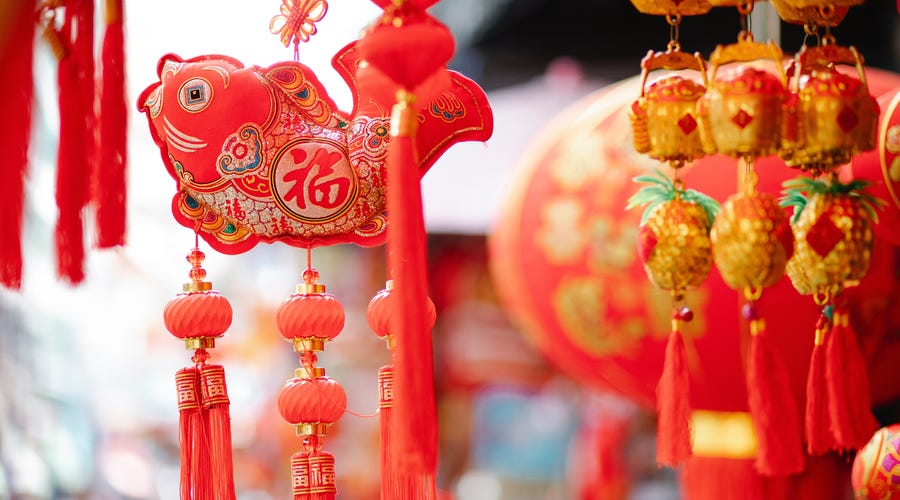
Mandarin vs. Cantonese: What's the difference? An easy guide
Author: Marco Monroy
Chinese is a special group of languages that includes both Mandarin and Cantonese.
If you grew up speaking English, then you can probably think of many dialects: British English, North American English, Australasian English, and so on. And, although it may take a little getting used to, you likely can understand almost everything any speaker of any English dialect can say without much trouble. That means that English dialects are mutually intelligible — you can understand someone who speaks a different dialect within the same language.
But what about Chinese? Most know that Chinese is made up of different “dialects,” but does that mean that everyone can understand each other regardless of the specific dialect they speak?
Well, the answer is a bit complicated. For starters, most Chinese languages are not mutually intelligible. That means that two people could both speak “Chinese” and still not understand each other. It also means that there are multiple types of “Chinese” that you can learn as a foreign language.
So, why are both Mandarin and Cantonese considered to be the same language? That’s because of shared historical roots and the use of the Chinese writing system. Though these dialects sound almost nothing alike, they pretty much use the same characters for the same words.
If all of that sounds very complicated, do not worry. We’ll take a close look at both Mandarin and Cantonese over the next couple of sections to help you get a clear understanding of the differences in pronunciation, characters, vocab, and grammar between these two dialects. We’ll also give you some advice on which one to pick if you’re looking to learn Mandarin or Cantonese.
Let’s get started!
.jpg?auto=webp&format=pjpg&quality=80&)
Mandarin vs. Cantonese overview
| Mandarin | Cantonese | |
| Language family | Mandarin Chinese | Yue Chinese |
| Where it’s spoken | Mainland China, Taiwan, Singapore, Malaysia | Southeast China, Hong Kong, Macau, and Chinese diaspora |
| Romanization system | Pinyin | Jyutping |
| Spoken characteristics | 23 initials | 19 initials |
| 35 finals | 58 finals | |
| 4 tones (plus neutral tone) | 6 tones plus 3 entering tones | |
| Characters | Mostly simplified characters | Mostly traditional characters |
| Usefulnenss | Used across the Sinosphere as a common tongue | Mostly useful in Hong Kong, Macau, and Guangdong |
Where Mandarin and Cantonese are spoken
First, you should know that Mandarin is by far the most common Chinese dialect. That’s because it’s the official language of mainland China, Taiwan, and Singapore, and serves as an official or recognized language in Hong Kong, Macao, Malaysia, and even the United Nations!
The wide territorial expanse of Mandarin is mostly due to it being recognized as the lingua franca of the Sinosphere. No matter one’s native dialect, almost all Chinese speakers are able to communicate in Mandarin to some extent.
The Chinese name for Mandarin is 普通话 (pǔ tōng huà), which translates into the common language. Its status as a common language has also propelled its importance in classrooms across China and consequently made Mandarin the most common language in Chinese TV shows, movies, and books.
Additionally, the overwhelming majority of the Chinese population speaks Mandarin as its first language. Some of the regions and provinces with the most native Mandarin speakers include:
- Beijing
- Hebei
- Shandong
- Inner Mongolia
- Shandong
- Henan
- Shaanxi
- Gansu
- Xinjiang
- Jiangsu
- Anhui
- Hubei
- Sichuan
- Guizhou
- Yunnan

Cantonese, on the other hand, is spoken natively almost exclusively in Southeast China. The Chinese city of Guangzhou and the province of Guangdong both used to be romanized as Canton, which is where the name Cantonese came from. Although this may sound like a small area, Guangdong is actually the most populous province in China, helping make Cantonese one of the top 20 most spoken languages in the world!
Besides natives in and near Guangzhou, Cantonese is also a common language amongst the Chinese diaspora in Southeast Asia, Europe, and North America, with Cantonese speakers making a majority of Chinese migrants up until the mid-20th century.
Cantonese has significant native speakers in the following regions:
- Guangdong
- Guangxi
- Hong Kong
- Macao
- Overseas Chinese diaspora
All in all, Cantonese has around 75 million native speakers worldwide.
Differences in pronunciation
As you now know, Mandarin and Cantonese aren’t mutually intelligible as most words have different pronunciations. However, the phonetic differences don’t end there — they also have different tonal rules!
Mandarin uses four tones to differentiate words. There’s also a fifth “neutral” tone, so you could consider a grand total of five tones for Mandarin.
| Tone number | Tone name | Description | Pinyin diacritic | IPA diacritic | Example | Example pinyin |
| 1 | 阴平 - yīnpíng | High | ā | /á/ | 巴 | bā |
| 2 | 阳平 - yángpíng | Rising | á | /ǎ/ [a᷄] | 拔 | bá |
| 3 | 上 - shǎng | Low (dipping) | ǎ | /à/ [à̤, a̤᷆, a̤᷉] | 把 | bǎ |
| 4 | 去 - qù | Falling | à | /â/ | 爸 | bà |
| 5 | 轻 - qīng | Neutral | a | Various | 吧 | ba |
Cantonese, on the other hand, uses nine tones to differentiate pronunciation! Of these nine tones, three are known as “checked tones,” which are used exclusively by syllables that end in a stop consonant or a glottal stop (-p, -t, -k).
These are the nine tones in Cantonese:
| Type | Tone number | Tone name | Description | Example | Tone letter | IPA |
| Open syllables | 1 | dark flat (陰平) | high level, high falling | 詩, 思 | siː˥, siː˥˧ | síː, sîː |
| 2 | dark rising (陰上) | medium rising | 史 | siː˧˥ | sǐː | |
| 3 | dark departing (陰去) | medium level | 試 | siː˧ | sīː | |
| 4 | light flat (陽平) | low falling, very low level | 時 | siː˨˩, siː˩ | si̖ː, sı̏ː | |
| 5 | light rising (陽上) | low rising | 市 | siː˩˧ | si̗ː | |
| 6 | light departing (陽去) | low level | 是 | siː˨ | sìː | |
| Checked syllables | 7 (or 1) | upper dark entering (上陰入) | high level | 識 | sek˥ | sék |
| 8 (or 2) | lower dark entering (下陰入) | medium level | 錫 | sɛːk˧ | sɛ̄ːk | |
| 9 (or 3) | light entering (陽入) | low level | 食 | sek˨ | sèk |
Differences in the characters
We saw earlier in the article that written Chinese is largely the same across dialects. But, now that you know how extensive the differences in pronunciation are, you’re probably wondering how Mandarin and Cantonese use the same characters.
The truth is, standard written Cantonese is based largely on written Mandarin. Thus, those who speak Cantonese technically use Mandarin to write in non-informal situations. Cantonese is actually in a state of digraphia, which means that there are two written standards for this dialect. Cantonese speakers use a colloquial adaptation of spoken Cantonese when writing in very informal situations and for Cantonese words that aren’t present in Mandarin. In all other cases, Cantonese speakers use a form of written Chinese that more closely resembles that of Mandarin.
This isn’t a new concept, as Classical Chinese was used as a common written language up until the early 20th century. Although not specifically tied to any single Chinese dialect, all literate Chinese speakers followed Classical Chinese written rules. Throughout the 20th century, though, the use of Classical Chinese was replaced with written Mandarin, largely due to national efforts to increase the literacy rate across mainland China.

Simplified vs. traditional characters
Another big difference you might notice is the prevalence of traditional characters in Cantonese-speaking environments. Today, simplified Chinese is used almost exclusively everywhere in mainland China and Singapore. However, Cantonese-speaking Hong Kong and Macau still use traditional characters for writing. Given that Hong Kong is a media powerhouse largely thanks to the success of the Hong Kong film industry, you’ll likely encounter plenty of traditional characters in Cantonese-speaking places.
Keep in mind that Cantonese speakers in mainland China tend to use simplified characters, and Mandarin speakers in Taiwan use traditional characters. Thus, you can’t assume that traditional characters mean that something’s in Cantonese or that simplified characters mean it’s in Mandarin.
Characters unique to Cantonese
Although Cantonese follows the same grammar rules as Mandarin, there are certain Cantonese words that simply don’t exist in Mandarin. So, a Mandarin speaker won’t be able to understand 100% of Cantonese texts, as some characters are completely unique to Cantonese. Here are some of the most common Cantonese characters that don’t exist in Mandarin.
| Cantonese | Jyutping | Mandarin equivalent | Meaning |
| 佢 | keoi5 | N/A | He, she, it |
| 嘅 | ge3 | 的 | Possessive particle equivalent to Mandarin 的 (de) |
| 嗰 | go3 | 那 | That as in “that one” |
| 喺 | hai2 | 在 | To be at |
| 佬 | lou2 | N/A | Male |
| 乜嘢 | mat1 je5 | 什么 | What or why |
| 咗 | zo2 | 了 or 过 | Puts the sentence in past tense |
| 咁 | gam3 | 这样 | So as in “so good” |
| 啱 | ngaam1 | 对 | Correct |
| 瞓 | fan3 | 睡 | Sleep |
Differences in vocab & grammar
Besides pronunciation and characters, Mandarin and Cantonese are also different in terms of vocabulary and grammar. I know, at this point, you’re probably wondering why they’re even considered part of the same language family if they’re so different. Well, luckily, this is one part where they actually have some similarities in addition to differences! Let’s get into the vocab and grammar differences and similarities between Mandarin and Cantonese.
Vocabulary
Most words in Mandarin and Cantonese are written with the same characters. This gives the languages a level of mutual intelligibility, allowing Mandarin speakers to understand written Cantonese and vice-versa.
However, that doesn’t mean that both dialects use the exact same words all the time. Beyond the unique Cantonese words we just learned above, there are a few vocabulary words that can be different in each dialect.
| English | Mandarin | Pinyin | Cantonese | Jyutping |
| To eat | 吃 | chī | 食 | sik6 |
| Beautiful | 美 | měi | 靚 | leng3 |
| To look | 看 | kàn | 睇 | tai2 |
| To stand | 站 | zhàn | 企 | kei5 |
| To cry | 哭 | kū | 喊 | haam3 |
| Potato | 土豆 | tǔ dòu | 薯仔 | syu4 zai2 |
| Eggplant | 茄子 | qié zi | 矮瓜 | ai2 gwaa1 |
| Grape | 葡萄 | pú tao | 提子 | tai4 zi2 |
| Tomorrow | 明天 | míng tiān | 聽日 | ting1 jat6 |
Grammar
Mandarin and Cantonese grammar are very similar, as evidenced by their basic sentence structures:
Basic Mandarin sentence structure:
Subject + Verb + Object (SVO structure)
Basic Cantonese sentence structure:
Subject + Verb + Object (SVO structure)
On a superficial level, both Mandarin and Cantonese follow the same pattern. However, that doesn’t mean that grammar rules are identical. After all, each dialect is its own language and comes with its own distinct grammar rules.
Here are the most common grammar differences between Mandarin and Cantonese:
- Adverb order. In Mandarin, adverbs are usually placed before the verb, whereas Cantonese places them after the verb.
- Double objects. In Mandarin, the indirect object always comes before the direct object, whereas the opposite is true in Cantonese.
If that seems a bit difficult to visualize, check out the following sample sentences comparing Mandarin sentences to Cantonese sentences.
| English | Mandarin | Pinyin | Cantonese | Jyutping |
| You go out first | 你先出去 | nǐ xiān chū qù | 你出去先 | nei5 ceot1 heoi3 sin1 |
| Where are you from? | 你是哪国人? | nǐ shì nǎ guó rén? | 你係邊度人呀? | nei5 hai6 bin1 dou6 jan4 aa1? |
| He gives me money | 他给我钱 | tā gěi wǒ qián | 他給錢我 | keoi5 bei2 cin2 ngo5 |
| What’s your name? | 你叫什么名字? | nǐ jiào shén me míng zi? | 你叫做乜野名呀? | nei5 giu3 zou6 mat1 je5 ming4 aa1? |
| Long time no see | 好久不见 | hǎo jiǔ bu jiàn | 好耐冇见 | hou2 noi6 mou5 gin3 |
Which one to learn?
Deciding whether to learn Mandarin or Cantonese is a personal decision that largely depends on your goals. In terms of utility, Mandarin will be far more useful than Cantonese, as it’s the only official language of mainland China and has over 10 times as many speakers. If you want to do business in mainland China, this is the language for you.
Mandarin is also the lingua franca of mainland China, meaning that many people speak it as a second language. For example, many Shanghai natives will use Shanghainese to communicate with each other, although virtually everyone in Shanghai can speak Mandarin. So, even if you’re not in a Mandarin-speaking region, being able to speak it may still help you communicate with locals. The same cannot be said for Cantonese, as very few people outside of Guangdong, Hong Kong, and Macau speak Cantonese if it’s not their native language.
However, Cantonese could be more helpful for you if you’re planning to relocate to Guangdong, Hong Kong, or Macau. While Mandarin will take you far in the Cantonese-speaking regions of mainland China, that isn’t the case for either of the Chinese Special Administrative Regions (SARs). So, if life is taking you to Guangdong, Hong Kong or Macau, then your best bet is to learn Cantonese.

Is Cantonese harder to learn than Mandarin?
We know what you’re thinking: okay, the utility of each dialect is one thing but, is Mandarin or Cantonese harder? And we don’t blame you! After all, Chinese is one of the hardest languages for English speakers, so approaching it with some caution is quite prudent.
Most people will agree that Mandarin is slightly easier to learn than Cantonese. Cantonese has four more tones than Chinese, and then traditional characters tend to be more common in Cantonese than in Mandarin. If you’re looking for the one that will take the least amount of effort to learn, then it’s going to be Mandarin.
However, most of our top tips to learn Chinese characters require a continued interest in studying and learning the language. Your personal interests, family and friends, business endeavors, and even learning opportunities will drastically impact how well you can study a language. So, if you have a passion for Hong Kong cinema or found a killer business venture in Guangzhou, don’t worry too much about Cantonese being slightly harder than Mandarin and simply go with your gut instinct!
Fun facts: Mandarin vs. Cantonese
1. Cantonese is very common in Chinatowns around the world
If there’s a Chinatown in or near your hometown, then you’re much more likely to be familiar with Cantonese than with Mandarin. In fact, did you know that the first Chinatown in the United States used to be called Little Canton? That’s because most Chinese immigrants in the 20th century came from Hong Kong and Guangdong province, thus spreading the use of Cantonese among the Chinese diaspora.
2. Mandarin has more than 10 times more speakers than Cantonese
Mandarin is spoken by over 1.1 billion speakers around the world, with about 929 million people calling it their native tongue. That makes Mandarin the language with the most native speakers in the world and the second-most spoken language after English. Cantonese, on the other hand, is estimated to have around 75 million speakers around the world, making the Mandarin-to-Cantonese speaker ratio almost 15-to-1!
3. Cantonese has more speakers than languages like Korean or Persian
Don’t let Mandarin’s relative might trick you into thinking that Cantonese is a small or uncommon language. Although it has far fewer speakers than its sister tongue, Cantonese is still one of the 20 largest languages in the world, with more speakers than popular languages like Korean and Persian!
4. The locals have never referred to Guangzhou as Canton
Although the most common romanization for the city of Guangzhou (and, by extension, the province of Guangdong) was Canton for centuries, the locals never referred to it as such. It comes from the Portuguese Cidade de Cantão, with Cantão being a misunderstanding of a dialectical pronunciation of Guangdong.
As the Portuguese established the first contact between Europe and East Asia in 1517, the name Canton stuck among Europeans and later among most Western countries. However, this name comes from a misunderstanding, which is why it’s since been mostly phased out. Maybe it’s time to rename Cantonese into Guangongnese or Guangzhousian!
Mandarin vs. Cantonese FAQs
Do all Chinese people speak Mandarin?
Not all Chinese speakers speak a Mandarin dialect, but an overwhelming majority of them do. It is estimated that around 80% of the population of mainland China can speak Mandarin, with plans to increase the level to 85% by 2025. However, the younger generation is almost fully fluent in Mandarin not only in mainland China but also in Hong Kong and Macau, as Mandarin has found its way into school curriculums.
Can Mandarin and Cantonese speakers understand each other?
Mandarin and Cantonese speakers cannot understand each other. The difference is pronunciation is too high for the languages to be mutually understandable. However, the differences in the written language are small enough that Mandarin and Chinese speakers could understand each other when texting or writing letters to each other.

Can I use Mandarin in Hong Kong?
About half of the people in Hong Kong (48%) can speak Mandarin, largely due to the rising number of mainland immigrants and tourists and the growing prevalence of Mandarin in education. However, if you’re a foreigner who speaks English and Mandarin but not Cantonese, your best bet is going to be to use English to communicate with the locals. English is still a very popular language and one of the official languages of Hong Kong, so you won’t run into any trouble with English.
Is Taiwanese Mandarin the same as Mainland China Mandarin?
Mandarin is the official language of both mainland China and Taiwan. While the Mandarin spoken in Taiwan and that on the mainland are very similar, there are key differences in pronunciation, grammar, writing style, and vocabulary. Most significantly, Taiwan uses traditional characters, while mainland China uses simplified characters. So, if you’ve learned simplified Chinese and find yourself in Taiwan, you may have some trouble reading signs on the street!
Learn your favorite of the sister tongues
We hope that clears things up! Although comparing Mandarin vs. Cantonese can be a little complicated, they are still both part of the Chinese language family. If you’re interested in picking either one of them up, then we encourage you to give it a shot! Although learning Chinese can seem like a gargantuan task, there are well over a hundred million people studying Chinese as a foreign language right now, serving as proof that learning this fascinatingly-complex language is certainly doable.
If you enjoyed learning more about Mandarin and Cantonese, check out our Chinese blog, where we regularly publish insightful content to help you reach your learning goals. Best of all? All of our articles are always free, even if you aren’t already taking online classes with Berlitz! Why not dip your toes into Chinese by learning to count in Chinese numbers, understanding pinyin, or finding creative ways to say hi in Chinese?


